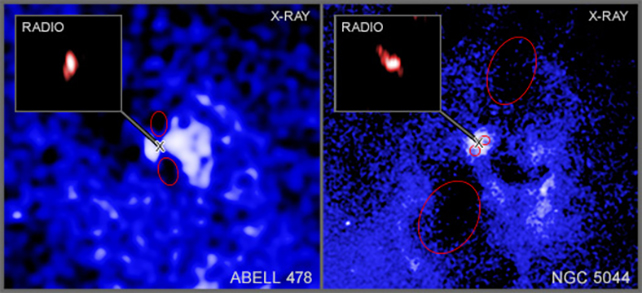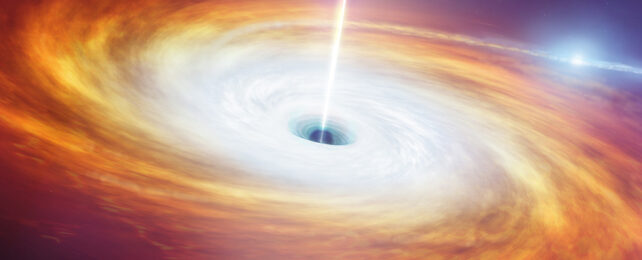In recent years astronomers have spotted signs that the jets of plasma particles fired out from supermassive black holes can actually change direction over time – and new research now shows the phenomenon can occur over a shockingly short time scale.
These jets are caused when heated material falling towards a black hole is channeled by powerful magnetic fields towards its poles and streamed back out into the cosmos. These beams of energy are thought to play an important role in star formation, so we need to know how they work.
An international team of researchers looked at 16 galaxies with black holes at their center, working with data obtained from the NASA Chandra X-ray Observatory and the Very Long Baseline Array (VLBA) network run by the National Radio Astronomical Observatory.

The researchers were able to compare radio wave data (showing where the jets are currently pointing) with cavities in the hot gas around the black holes (showing where the jets have pointed in the past).
"We found that about a third of the beams are now pointing in completely different directions than before," says astrophysicist Francesco Ubertosi from the University of Bologna in Italy.
"These Death Star black holes are swiveling around and pointing at new targets, like the fictional space station in Star Wars."
About a third of the jets studied (30-38 percent) appear to have significantly changed course (by 45 degrees or more) across a period of 10 million years or less. That suggests this is a relatively common occurrence with supermassive black holes.
In some cases, changes in direction of almost 90 degrees were observed, while the shortest time periods for change were as little as one million years. Taken on the cosmic scale, that's actually quite a rapid realignment.
"Considering that these black holes are likely more than 10 billion years old, we consider a large change in direction over a few million years to be fast," says astrophysicist Gerrit Schellenberger from the Center for Astrophysics | Harvard & Smithsonian (CfA) in the US.
"Changing the direction of the giant black hole beams in about a million years is analogous to changing the direction of a new battleship in a few minutes."
Since these jets make it harder for gas to coalesce and form stars, any changes in their orientation have important implications for the makeup of their surrounding galaxies.
While it more than likely means fewer stars are generated, there isn't enough data to determine if existing stars and planets might be affected by the sweep of the black hole's beams.
What's not yet clear is what's causing this Death Star-like swiveling, although the researchers have some ideas, and many different factors could be dragging the jets in different directions. Further studies should help establish what's happening.
"It's possible that material rapidly falling towards the black holes at a different angle for long enough would drag their rotation axes in a different direction, causing the beams to point in a different direction," says Jan Vrtilek from CfA.
The research has been published in the Astrophysical Journal.
